Pocket forests: A growing idea finds a home in urban settings
Catherine Cleary and partner Ashe Conrad-Jones of Pocket Forests are dressed for action. The team is giving Ireland a taste of what life could be if there was more nature.
Akira Miyawaki is original creator of mini forest
Why plant a tree when you can plant a miyawaki forest?
It’s a concept that I have always thought made a lot of sense and there is actually a movement taking root, especially in parts of Europe and North America, that encourages planting an intensive mini forest.
This process of creating a small, native forest in a fraction of the time it would normally take in nature, goes by several names: including “micro forest” or “Miyawaki Forest.” In Ireland, a group of young women are even creating a business focusing on what they call a “Pocket Forest.” (But more on their efforts later in the article.)
The mini forest has its roots in the 1970s with the work of a Japanese botanist named Dr. Akira Miyawaki, hence the original name “Miyawaki Forest.” It’s a method he perfected and one that has since been adopted by a number of people looking for a way to recreate a natural forest in a very short period of time – primarily with the aim of restoring native flora and fauna as well as sequestering carbon in an attempt to save the environment from global warming.
Since Dr. Miyawaki discovered the benefits of this method it is estimated that more than 40 million trees have been planted using the Miyawaki Method.
If you are interested in exploring the world of shade gardening further, you might like my recent post on The Natural Shade garden.
Pocket Forests are becoming an important factor in helping rejuvenate nature in Dublin, Ireland.
So what is the Miyawaki method?
It is a scientifically proven method of growing a very small (in some cases tiny) urban forest of native trees and plants in the span of 20 to 30 years – a process that normally would take 200-300 years if left to nature.
A traditional forest grows in three stages: primary, secondary and finally the climax stage. The Miyawaki method skips the first two stages and moves directly to planting a very intensive climax-stage forest and climax community that is planted so dense that the trees, (a variety of native trees and shrubs) skyrocket up competing with one another for light. The result is a miniature, well-balanced ecosystem that works together above and below ground to create the miniature forest. The fact that everything is native, means that the miniature forest is able to maintain balance, is tolerant of the conditions and attracts a myriad of native plant and animal life. A study even showed that one forest attracted 600 species of plants and animals.
Miyawaki mini forest compared to commercially grown plantation
You may say that we have been growing forests for years, replanting forested areas that have been harvested for old growth trees, so why would this method be any different?
Here are some interesting comparisons between the growth of a commercially-grown plantation and a pocket forest.
The trees grow ten times faster in the pocket forest and are 30 times more dense than the trees in a commercial plantation.
Studies have also shown that the pocket forest boasts 100 times more biodiversity and is 100 times more organic than the commercially grown plantation.
Conventional forest compared to mini forests
If that’s not enough, compared to a conventional forest, the pocket forest boasts 30 times or more carbon-dioxide absorption.
If planted properly, it has a guaranteed growth of at least one meter per year and after the initial few years is completely maintenance free.
In as few as three years you have the beginning of a native forest that is completely chemical and fertilizer free with little to no maintenance after two years.
Catherine Cleary and business partner Ashe Conrad-Jones ready for another day of creating Pocket Forests.
How small can the forests be?
These forests can be incredibly small. In fact, in urban centres it is not uncommon to create a forest the size of a typical parking spot at a mall parking lot. One forest was created inside a large, steel, garbage container in an urban/industrialized area.
“We can fit our smallest one into 6 square metres. That’s about the size of a single car parking space. So they can go lots of places… In that small space we plant 11 different species,” explains Catherine Cleary, a co-owner of Pocket Forests in Dublin Ireland.
Catherine, a journalist who was writing about food and reviewing restaurants when Covid hit in February 2020 and her business partner Ashe Conrad-Jones, who runs a small events design business, decided to team up in 2020 and create “pocket forests” based on the Miyawaki method.
“Together we decided that the shutting down of restaurants and events was an opportunity to explore an idea we thought would be perfect for our area of Dublin – a part of Ireland that has the least amount of green space per person in the country. We contacted Afforest in India and IVN in the Netherlands about the Tiny Forests they were planting in urban areas and set up our social enterprise in the summer of 2020 to bring the idea to Irish towns and cities,” explains Cleary.
“No one will protect what they don’t care about; and no one will care about what they have never experienced.”
A Pocket Forest beginning to put on growth. Notice how closely the trees are planted together.
It hasn’t been easy but the team has now grown to three with Amy joining Catherine and Ashe in January 2022. She had been working with another local social enterprise, the Dublin Food Co-Op for a decade and wanted to make a change.
How many Pocket forests have been planted?
It’s still early, but Clearly says the company has planted nearly 50 pocket forests since they started, ranging in size from six square metres to 100 square metres.
“We have faced lots of challenges, launching a business while trying to maintain our other “jobs/gigs,” explains Cleary in an email to Ferns & Feathers.
“We had to learn a lot about how to do this. It is not a conventional form of forestry or horticulture but a space all of its own,” explains Cleary. “We have struggled, until very recently, to find native plants grown organically but that is improving and in our first season we had to find temporary homes for hundreds of trees so we could use them in the next bare-root season. (We built a raised bed in my front garden and borrowed a patch of land from a cousin.)”
Part of the companys challenges is convincing local authorities that native trees and shrubs actually belong in the urban areas.
“There is a growing movement to move toward hardier, drought-tolerant, non-native trees that the horticulture industry claims will cope with climate changes and the hostility of city conditions, Cleary explains. “We argue that we should change those conditions by planting pocket forests rather than lone trees as they are incredibly resilient ecosystems, help reverse biodiversity loss and maintain our connections with native trees and shrubs.”
Their arguments get a lot of support from Peter Wohlleben, author of the 288-page, New York Times best seller The Hidden Life of Trees. In his writings, Wohlleben focusses on the importance of a community of trees working together rather than a single tree in an urban environment all on its own. He compares these lone urban trees with “street kids” trying to survive in harsh conditions on their own. These trees have a much shorter lifespan, do not grow as large and are in a daily battle for food, water and a source of healthy soil amidst the concrete of big city life.
How important is soil to Pocket Forests?
Soil, Cleary admits, is vital for the success of a Pocket forest.
“Increasingly we are fascinated by soil health and involving people who live or work or go to the school near the forests in making them so that they can become forest keepers and get all the benefits of those connections with the natural world,” Cleary explains.
“That is our mission: reconnecting people with the natural world, regenerating soil and THEN planting trees, in that order,” Cleary explains
“We love the first forest we worked on, in the grounds of a local school. It is still our largest forest and it is breathtaking to see how the plants are thriving. It is teeming with life both above and below ground and it is just in its second growing season. My own pocket forest in my garden gives me joy every day. I look closely at everything that's happening in it from day to day and season to season and it feels like a vital part of my day to do that.”
Presently, the Pocket Forest team, is working with five schools to plant larger forests this season and are just beginning to prepare the soil this month with two of them.
But their work is constantly growing and sometimes takes them into unusual places.
“We have established a small nursery in an open prison about an hour from the city and will be holding a workshop on their family day to talk to people about the trees, our obsession with worms and soil. We carry out compost workshops in our partner The Digital Hub, a local Government campus where tech start ups and other small companies are based. We are hoping to plant a balcony forest outside a neonatal unit in our local Children's Hospital.”
Currently, the women don’t work outside Ireland, but have done a cross-border project in Newry in Northern Ireland.
Super fertile soil plays a vital role in the success of the Pocket Forest.
Pocket Forest team Q&A
Ferns & Feathers sent Catherine and the Pocket Forest group a series of questions about their work, including how their system might benefit existing woodland gardeners or, if there Pocket Forests could be used for a typical new home here in North America. The following are their highly informative and inspirational answers to the questions.
1) Why did you get involved in creating these forests and do you feel they are an important factor in dealing with climate change into the future.
Cleary: “It was a very personal decision about using my time in the climate and biodiversity crises to try to help alleviate problems.
There’s a quote from David Attenborough that we kept returning to in early presentations: “No one will protect what they don't care about; and no one will care about what they have never experienced.”
“Native Irish forests account for less than 2 per cent of our land habitats and many of them are inaccessible to people, growing in remote areas. Putting a version of them into places where most people live (towns and cities) links up the more wide-scale reforestation project that is going to be vital in the years ahead. We learned very quickly how positively everyone responds to the work of putting spades or forks in the ground, mulching soil with healthy compost, worms, leaf mulch and woody material to begin to try to create the conditions naturally found on a healthy forest floor. We've learned so much from the new science revealing the collaborations between plants and soil life to create thriving ecosystems. Healthy forests can be a huge help in sequestering carbon but we don't see pocket forests as a carbon-offset idea. We need to stop emitting carbon, protect existing forests and create new ones. We need to restore the reverence that Irish people used to have towards trees, the sense that the natural world is more powerfully in control of the system than we are and our efforts to impose our ideas of what looks good or extract resources without protecting the soil life all have to change. Forests are the healthiest systems and have so much to teach us about what it is that the land longs for, and how putting “forest-thinking” into how we produce food or plan cities or teach children about the world will only make things better.”
2) What are the responses of your clients 1-2-3 years down the road as the forests thicken?
Cleary: “Some of them wonder about the wildness of what they have - aphids regularly attack some plants and we've had some clients wonder about them. We give them an information booklet and for people with restricted space there are pruning instructions to keep the trees from growing to their full size. In bigger sites we are advising people to let the trees do their thing, and so far they are.”
3) Are there lessons that can be learned from Pocket forests that can be used in regular forests and woodlands to move them along more quickly or are the steps so precise that they do not translate well to traditional woodlots or forests?
Cleary: “The healthiest forest creation is done by forests. Given the chance (fencing land from grazing or mowing or spraying) a field surrounded by a native hedgerow will become a forest as the trees and shrubs seed themselves. Some management may be needed to keep invasive species out but that is really all anyone needs to do. So we take all our lessons from that. Soil management could be better done than it is at the moment in mainstream forest-creation. Foresters are still using herbicides to spray off competing vegetation after they plant young trees. This is counterproductive and we would definitely love to see mainstream forestry taking a more regenerative approach. We still clear-fell tree plantations for timber and that has to change. Continuous cover forestry is far more sustainable and ancient practices like coppicing could be rediscovered using pocket forests in schools as they grow and become established.”
The team behind Pocket Forests preparing to install yet another of their hard-working miniature forests.
4) How important is it to use native trees and plants in the creation of the Pocket Forests.
Cleary: “It's very important that the core of a pocket forest is native trees and shrubs. We don't mind if people also want to add in fruit trees and shrubs and add flowering plants to the edges of a pocket forest but the majority of it must be native.”
5) Is there anything homeowners who have their own woodland/wildlife gardens can take away from the success of the Pocket Forests?
Cleary: “Spend time enjoying your woodland or wildlife garden, see how its circular system - cycling leaf fall and branches into soil, creates a maintenance free ecosystem. It doesn't need watering, weeding or feeding. Then apply that forest thinking in your vegetable garden or flower beds. Mulch, don't dig, allow what arrives in your garden to take its space before you try to carve out all the space for your idea of what it should be.”
6) For new homeowners looking to create a woodland garden in their typical suburban backyards, would a Pocket Forest work, or would it be too intensive to be successful in a typical urban garden…?
Cleary: “We choose species that can be pruned to stay small in my very small back garden - it is a version of a forest, almost a specimen forest, a form of large-scale bonsai where the closeness of the roots and some gentle pruning in winter keeps the trees from growing to their full size. This can prolong the life of a tree ( a laid hedge can grow for 1,000 years) and also gives garden birds, soil life and insects so much habitat.”
7) Cleary: “What other words of advice might you give to those wanting more information on establishing a Pocket Forest whether it’s in their own backyard or schoolyard…”
8) Cleary: “Can the same approach be used to create a food forest that might be useful to help feed families in need etc.?
Cleary: “Community food forests have wonderful potential to reconnect families with where food comes from. Unlike an allotment where much time and skill is needed with the right planting a food forest can do much of the hard work itself and people can interact with it for enjoyment rather than the constant battling against weeds that happens in bare-soil allotment gardening. A food forest would take time to establish and it would be a stretch to say they could solve food poverty. But fruit and nuts from a food forest will be higher in nutrients and vegetable growing can be incorporated into food forests. The abundance of a food forest also lends itself to community kitchen operations where fruit or vegetable gluts can be cooked or preserved and shared.”
9) You have put in Pocket Forests in schools. What are the children’s reaction to the almost instant forests you have helped them create.?
Cleary: “They love the forests but they also love the work of creating them. Many of the children we work with have no gardens, not even balcony space to grow things and get their hands in the soil and have contact with its health benefits. One girl talked about her trees being her legacy to the school. That made us very happy (and tearful). The children who need it the most are the ones that we see blossoming when we go in to work on a pocket forest project. We would love to grow the enterprise to be able to offer training and jobs to these young people, to train an army of pocket foresters for the future.”
Why should we use native plants in our gardens?
Why should we use native trees, shrubs and plants in our landscapes is an important question many gardeners ask. Native plants are vital for the survival of our birds, pollinators and other animals that depend on the food these plants provide. It’s never been more important for gardeners use more native plants and save our environment one garden at a time.
Native plants trees and shrubs vital to our environment
Why is it so important to grow native plants?
It’s a question many gardeners are asking as the pleas to use native (trees, shrubs and plants) grow louder throughout social media circles, environmental gardeners and even traditional garden clubs.
This move toward native plants has grown steadily as an increasing amount of evidence has come forward to show a direct relationship between native plants and the survival (and abundance) of our native insects and caterpillars.
Why does this matter?
Using native plants matters because insect larvae, caterpillars even egg masses are key to the survival of so many of our birds, reptiles, amphibians and mammals that depend, not just on the existence of these insects, but on an abundance of them in spring to raise their young.
It’s not just the protein the emerging insects provide.
Insects depend on these plants for food and pollinators depend on the flowers their ancestors have visited for thousands of years to raise their young (see Our Native Bees). The pollination of those flowers in spring lead to berries and nuts that provide sustenance for birds, mammals even more insects, which, in turn, provide food for larger predators such as fox, coyotes, owls…
It’s the circle of life in action, but that circle most often starts with the single seed of a native plant.
Native plants are, thankfully becoming more mainstream as more informed gardeners realize the how important these native plants, shrubs and trees are for native wildlife. The proof is that Little Bluestem native grass has been chosen the Top Perennial for 2022. Choosing a grass, rather than a colourful flower is reason enough to think we are making good progress. Be sure to check out my complete article on Little Bluestem.
A combination of milkweed, Black-Eyed Susans and columbines beneath a mature serviceberry tree combine with grasses and ferns welcome native fauna in our front garden.
Experts on the importance of using native plants
I particularly like this line from the website of the Halton Regions Master Gardener’s website talking about the growing popularity of native plant gardening.
“This is an exciting trend as it offers homeowners and gardeners the ability to build a landscape legacy for future generations. The status quo of landscaping solely to ‘decorate your home’ for your own benefit now seems rather empty because of course we share our space with creatures of all kinds. How can we create landscapes only for ‘us’?”
Well said. Indeed, how can we carry on like we have in the past worshipping great swaths of lawn that offer nothing of value to any of our native wildlife.
In her groundbreaking book Grow Wild: Native Plant Gardening in Canada, Lorraine Johnson describes yards she has visited planted with native flowers.
“For starters, the birds are squawking up a riot – an exuberant contrast to the silence next door, where no seedpods or berries or brush exist to lure them. And in the aural spaces between the drone of traffic, you catch a different kind of rhythm: the hum of insects, some losing the battle and becoming bird dinner, others making their way into flowers, drinking captured rainwater, picking up pollen.”
Johnson goes on to describe what she sees growing in the garden: “The winged diversity of this yard has its parallel on the ground too. Instead of the handful of plant choices offered throughout the neighbourhood, there are dozens of different plantings: colorful native meadow plants in the sunny center, and the subdued cooling greens of shady woodlanders in the darker corners. You count 50 species, and those are just the ones immediately identifiable.”
Entomologist Douglas Tallamy, in his book Bringing Nature Home: How You can Sustain Wildlife With Native Plants, (see my earlier story) explains the vital role gardeners are being asked to take on: “Like it or not, gardeners have become important players in the management of our nation’s wildlife. It is now within the power of individual gardeners to do something that we all dream of doing to make a difference. In this case, the “difference” will be the future of biodiversity, to the native plants and animals of North America and the ecosystems that sustain them.”
Native plants are the ecological basis upon which life depends. Without them and the insects that co-evolved with them, local birds cannot survive. For example, Tallamy’s research has shown that native oak trees support more than 500 species of caterpillars.
And what some gardeners might see as a pest is life-giving food to the birds that call our neighbourhoods home.
Chickadees, for example, need from 4,000 to 7,000 caterpillars to raise just one clutch of young, and those caterpillars need to be close to the nest – about 50 feet – otherwise the parent chickadees use too much energy finding the caterpillars.
If it takes more than 6,000 caterpillars to raise one brood of chickadees, the presence of important native trees such oaks, birch and maples are critical to the survival of our birds and other animals.
This outstanding poster created by Justin Lewis shows how native plants help our birds.
Why native plants matter
So this harsh reality begs the question: Why do the plants have to be native to our area?
The fauna (insects, birds, mammals, reptiles, amphibians) have depended on these plants for thousands of years. Their digestive systems, even specific body parts, have developed to take advantage of these plants.
In fact, some fauna are linked directly to a single native plant.
The monarch butterfly is a perfect example of the symbiosis between a plant species and fauna. Monarchs depend on milkweeds to raise their young. They lay their eggs only on the milkweed plants where they hatch into tiny caterpillars that feed exclusively on that plant and take up enough of the poisonous milky resin in the plant to make them poisonous to birds and help them to survive as they transform into beautiful monarch butterflies. Without the native milkweed plants, monarchs would not survive.
Time to battle the aliens
Tallamy does not sugar-coat the damage that has already been done by our dedication to growing often invasive, non-native plants.
“My argument for using native plant species moves beyond debatable values and ethics into the world of scientific fact,” he writes. “We can no longer hope to coexist with the other animals if we continue to wage war on their homes and food supplies. This simple tenet provides an imperative, particularly for the bird and butterfly lovers among us, to fight invasive aliens as if it really matters and to reevaluate our centuries-old love affair with alien ornamentals.”
What many gardeners and garden nurseries fail to understand is that, in most situations, only the native species of a plant provide the full benefits to native fauna. Cultivars of our favourite plants promise to solve one problem (mildew powder for example) but in doing so breed out many of the benefits the native species provide. It’s not uncommon, for example, for these cultivars to be sterile or “resistant” to the vary species that are attracted to and dependent on, the native species of that plant.
We all want the perfect plant in our gardens, but do we ever think that those holes in the plant are there because one of our native beetles depend on that plant as a food source? By making the plant indigestible to that beetle, we are denying it a valuable food source for the sake of garden aesthetics and, in doing so, signing its death notice over time.
These cultivars might look great in the garden but many do little to nothing to help the species that depend on them.
I love our beautiful Cornus Kousa dogwood trees in our garden. Unfortunately, they are an example of plants that have been introduced to our area from Asia that offer very little to local wildlife. Although these dogwoods act much the same as our native Florida Dogwood species by putting out a profusion of flowers that last well into the summer, followed by strawberry-sized red fruit, very few, if any of our local wildlife benefit from these trees.
The native dogwoods, however, are magnets for a range of insects, caterpillars, birds and mammals that have grown up with them over centuries and depend on them for sustenance. (see article on best dogwoods)
The sad fact is that the introduced Cornus Kousa dogwoods may well have brought with them a disease that is killing our native dogwood. Anthracnose, a disease that attacks native dogwoods (cornus florida) and eventually kills them, is suspected to have come into North America in the 1970s with the importation of the Kousa dogwoods which do not suffer from the bacteria.
“It is highly likely that dogwood anthracnose was imported into the United States on kousa dogwoods from Asia because it escaped detection at quarantine facilities.” Tallamy writes.
In our garden, we have both native and non-native dogwoods.
We are delighted to have the spring azure butterfly in our garden, thanks to the presence of our Florida Dogwood. It’s certainly not thanks to the impressive Kousa Dogwoods in our yard.
Tellamy writes: “The diminutive spring azure (Celastrina ladon), one of the first butterflies to become active as the days warm up in spring, may become a resident of your yard if you plant flowering dogwood (Cornus florida) or any of our native Viburnum species. They won’t appear if you insist on kousa dogwood (C. kousa) from Asia. Azures will have nothing to do with that alien.”
The Canadian Wildlife Federation website points out that the Karner Blue butterfly is endangered because its larval host plant, the wild lupine, is increasingly rare. Today’s abundant, non-native lupines do not offer the Karner Blue butterfly the source of food it’s caterpillar needs to survive.
“While all plants can provide shelter, and ornamentals with berries can provide some food, native plants offer the greatest benefit because they also support a wide variety of insects that provide a source of protein for many animals. These insects are especially necessary for local bird populations when they are raising young. Many people use bird feeders to attract birds. Another way of attracting birds is by utilizing native plants in the landscape.”
Native trees, shrubs and plants (zones 5-6)
The following are just a few of the more popular native trees, shrubs and flowering plants and grasses in Ontario and N.E. United States.
The list was compiled by landscape designer Angela den Hoed for the Woodland Wildlife garden design she created for Ferns & Feathers and lists the number of species the plant supports.
These trees provide both habitat and food in the form of caterpillars and insects for birds.
Oak – Willow (Quercus phellos), Pin (Q. palustris), or Bur (Q. macrocarpa): Oak trees support the highest quantity of wildlife of any plant in the region including 519 species. Their acorns also provide food for other wildlife.
Maple – Red (Acer rubrum) or Sugar (A. saccharum): Support 293 species. It may be easier to find a maple the appropriate size for a small garden.
Understory Trees
Crabapple – American/Sweet (Malus coronaria): Flowers in spring and provides fruit in the fall and throughout the winter. Supports 287 species.
Dogwood – Flowering (Cornus florida) or Pagoda (C. alternifolia): Flowers in spring and supports 124 species.
Plum - American (Prunus americana) or Chokecherry (P. virginiana): Plums are #2 on the list of trees in terms of the number of butterflies and moths they support (435). These will flower in the spring and provide berries for birds in the fall.
Serviceberry – Canadian Serviceberry (Amelanchier canadensis) or Allegheny Serviceberry (A. laevis): These also bloom in late spring, support 135 species and provide birds food in the form of berries in the fall.
Magnolia – Sweetbay Magnolia (Magnolia virginiana): Supports 20 species including a few that can only live on Magnolias.
Shrubs to consider
Arrowwood Viburnum (Viburnum dentatum): Spring flowers lead to blue-black berry like drupes that are an ideal fuel for bird migration. 111 species supported
Inkberry Holly (Ilex glabra) ‘Gembox’: 44 species supported
Red Osier Dogwood (Cornus sericea) – ‘Arctic Fire’: White flower, blue drupes in summer, red fall color, bright red branches in winter. Like the dogwood tree, supports 44 species
Pinxterbloom Azalea (Rhododendron periclymenoides): Pink flowers in spring, supports 53 species
Oakleaf Hydrangea (Hydrangea quercifolia) ‘Ruby Slippers’ or ‘Munchkind’: Supports 10 species.
New Jersey Tea (Ceanothus americana): White flowers in spring, supports 44 species.
Summersweet/Sweet Pepperbush (Clethra alnifolia) ‘Ruby Slippers’: Fragrant pink flowers in summer, attracts hummingbirds and pollinators.
Perennials to consider
• White Wood Aster (Aster divaricatus): White flowers late summer, supports 115 species
• Columbine (Aquilegia canadensis): Red flowers in spring, Supports 12 species.
• Cinnamon Fern (Osmunda cinnamomea): Cinnamon red new growth, supports 7 species.
• Virginia Bluebells (Mertensia virginica): Blue flowers in spring, supports 3 species.
• Early Meadow Rue (Thalictrum dioicum): Greenish yellow flowers in spring, supports 15 species.
• Short’s Aster (Symphyotrichum shortii): Blue-violet flowers in fall, supports 11 species.
• Goat’s Beard (Aruncus dioicus): Tall white flowers in May.
• Coral Bells (Heuchera villosa) ‘Autumn Bride’: White flowers late summer.
• Tall Thimbleweed (Anemone virginiana): White flowers in summer, supports 2 species.
• Foamflower (Tiarella cordifolia): White or pink flowers in May.
Ground covers to consider
• Dwarf Crested Iris (Iris cristata): Blue-violet flowers in April, supports 13 species.
• Wild Ginger (Asarum canadense): Burgundy flowers in spring at the ground.
• Wild Blue Phlox (Phlox divaricate): Blue flowers in spring, supports 3 species.
• Wild Geranium (Geranium maculatum): white, pink, or purple flowers in spring, supports 27 species.
Other reasons to grow native plants
Of course there are lot of good reasons to grow native plants that are not related to the protection of our native flora and fauna.
The U.S. Forest Service points out some of the benefits on its website.
• They are adapted to the local climate and soil conditions.
• They do not require fertilizers and require fewer pesticides than lawns.
• Their deep-root systems increase the soil’s capacity to store water and can signinficantly reduce water runoff and, consequently, flooding.
• Native plants help reduce air pollution. (Not only do they not require mowing and the resulting carbon from the burning of fossil fuels, the plants actually sequester, or remove, carbon from the air.
• Native plants provide shelter and food for wildlife.
• Native plants promote biodiversity and stewardship of our natural heritage
What is a native plant?
The question is often asked: What exactly makes up a native plant?
The simple answer is that a native plant is one that has not been introduced by humans. One that has grown naturally for centuries and in doing so has become uniquely adapted to local environmental conditions.
Lorraine Johnson defines native plants as “a species that has evolved in association with all the features of a place and developed specific and important functional relationships and interactions that contribute to the specificity and identity of that place.”
Milkweed, the only food source for the caterpillars of Monarch butterfly, growing happily in our front garden alongside black-eyed Susans.
A native plant versus a naturalized plant
Many gardeners mistake native plants with naturalized plants. Just because they may freely reproduce and are abundant in the zone we live in does not mean they are native. Some may have been around for decades or even longer but they are still not natives.
Naturalized plants are often described as an exotic plant that manages to reproduce naturally in a specific environment.
A good example that we are all familiar with is the common dandelion. They have surely been around forever and we all know how easily they reproduce from seed.
So dandelions are naturalized plants that actually have some benefit to local fauna.
Other common plants, let’s say the daylily, cannot spread to new areas without human intervention. The daylily can grow in size through rhizomous growth but if you find it growing in a wild area, it got there not by seed but through the transplanting of its rhizome.
Invasive plants are defined by their spreading habit that actually results in an altering of the natural ecosystems around them, where they often dominate natural species crowding them out and eventually resulting in their death. The Norway maple, purple loosestrife, buckthorn and giant hogweed are just a few examples of invasive exotic species.
Many of these invasive, naturalized non-native flora species can still have benefits to local fauna, but in general, they do more harm than good. The use of a native plant as an alternate would be preferable.
In her 1998 groundbreaking book, Johnson writes of the importance of gardeners adopting a more environmental, native based style of gardening.
“You don’t need acres and acres of “pristine” wilderness to have a positive impact; indeed, it’s probably in those areas most stressed by urban pressures – denuded, defoliated and in decline – that we can make the biggest difference.
“By gardening with native plants, you are taking a giant leap toward ecological balance. she writes.
Have her words struck a chord with gardeners since she wrote the book in 1998?
Most definitely.
Is there more work to do?
Absolutely.
“We’ve got more than enough anyplaces already,” she wrote. …What we need are more landscapes, more gardens, that truly reflect the variety and vitality of each community’s character – and by community, I mean not just the human inhabitants but the communities of plants and animals which contribute so much to our identity our sense of where exactly it is that we call home.”
“With native-plant gardening, we become what the bioregional philosophers call dwellers in the land – partners, not parasites; participants, not parallel players; dwellers; not dictators.”
Certainly, a goal worth pursuing.
More information on native plants.
North American Native Plants Societies (find one near you)
Audubon: Why native plants matter.
Carolinian Canada Invasive Species list
More links to my articles on native plants
Why picking native wildflowers is wrong
Serviceberry the perfect native tree for the garden
The Mayapple: Native plant worth exploring
Three spring native wildflowers for the garden
A western source for native plants
Native plants source in Ontario
The Eastern columbine native plant for spring
Three native understory trees for Carolinian zone gardeners
Ecological gardening and native plants
Eastern White Pine is for the birds
Native viburnums are ideal to attract birds
The Carolinian Zone in Canada and the United States
Dogwoods for the woodland wildlife garden
Bringing Nature Home by Douglas Tellamy
A little Love for the Black-Eyed Susan
Native moss in our gardens
What tree should I plant in my backyard?
What tree should I plant in my garden? A question heard often in on-line forums and nurseries everywhere. The simple answer: Plant an oak tree. Its everything you want in a tree – solid, stately and it feeds, protects and is home to more forest creatures than any other tree you could plant. There is room in every garden design for an oak, and if you think there isn’t think again. Here are four great oaks to consider.
Four oak trees for your woodland wildlife garden
“We just bought our first house and we want to plant a tree. What’s the best tree to plant?”
It’s a question seen over and over again on gardening forums and one asked at local nurseries on a daily basis.
On Facebook gardening forums, the question is often immediately followed by a host of suggestions from well-meaning gardeners and homeowners offering up ideas ranging from tiny weeping hybrids to non-native, highly invasive trees.
Rarely does the word Oak tree show up.
Let me go on record to say that the best tree you can plant in your backyard woodland wildlife garden is an Oak. There are plenty of reasons to plant one of the 400 species of oak, but nothing is as important as one simple fact: Oaks support the most insect biodiversity of any tree in the woodland.
I remember when we moved into our current home. One of the first things I did in spring was to do an inventory of trees on the property. I was very happy to see a nice young oak tree growing happily in the back of the yard. Today it is a more mature oak that works hard for the birds and wildlife on our property.
If you are interested in exploring the world of shade gardening further, you might like my recent post on The Natural Shade garden.
An oak leaf covered in hoar frost in late fall.
Oaks are good for birds and wildlife
In his book Bringing Nature Home, Douglas Tallamy explains that a 2003 study found that a “single white oak tree can provide food and shelter for as many as 22 species of tiny leaf-tying and leaf folding caterpillars.” And that is just a tiny fraction of the fauna that depend on a single oak tree. In fact, the mighty oak supports 534 species of fauna, more than any other tree we can plant in our gardens.
It is followed by the willows, cherries and plums, in importance to fauna. All good choices when it comes to deciding what tree to plant in your garden.
If the Oak’s importance to wildlife is not enough, consider that of the 400 species of Oak, North America boasts 90 different species with 75-80 in the United States and 10 in Canada.
For more on the importance of oak trees in our garden and natural landscapes take a few moments to check out my other posts on Oak trees:
Oaks are long-lived trees
Oh, and no need to worry that the tree will die on you and leave a massive hole in the landscape, Oak trees traditionally live for hundreds of years. There’s a good chance your children will be watching the tree enter middle age long after you’re gone.
In Ontario and northeastern United States, that white oak you plant will grow more than 35 metres (that’s more than 114 feet) tall, can live for several hundred years and produce thousands of acorns every year to feed deer, squirrels (including flying, red and gray), chipmunks, wild turkeys, crows, rabbits, bears, mice, opossums, blue jays, quail, raccoons and even wood ducks just to name a few.
As Tallamy points out: “The value of oaks for supporting both vertebrate and invertebrate wildlife cannot be overstated.”
He explains that oaks along with hickories, walnuts and American beech, have stepped up to the plate following the demise of the American chestnut in supplying nut forage for various forms of fauna.
“Every oak tree started out as a couple of nuts who stood their ground.”
In addition, oaks – both living and dead – provide nesting cavities for our backyard birds ranging from chickadees, wrens, woodpeckers, owls and even bluebirds.
The tree species real genius, however, is what we alluded to earlier, and that is the astounding number of insect herbivores that oaks support in the forest ecosystem.
“From this perspective, oaks are the quinessential wildlife plants: no other plant genus supports more species of Lepidoptera, thus providing more types of bird food, than the mighty oak,” Tallamy writes.
(If you are wondering what the heck a Lepidoptera is: They represent an order of about 180,000 species in 126 families and 46 superfamilies of insects that includes butterflies and moths. It is one of the most widespread and widely recognizable insect order in the world, and your average oak is full of them.)
12 Cool facts about Oak trees
1) Not all acorns are created equally. Acorns produced by white oaks germinate just days after they fall from the trees. Acorns produced by red oak species germinate the following spring. Keep this in mind if you are trying to grow your woodland from seeds. It is estimated that only 1 in 10,000 acorns become trees.
Acorn hats after squirrels feasted on the fruit of the oak.
2) An oak tree produces about 2,000 acorns every year. These acorns contain plenty of nutrition including large amounts of protein, carbs, fats, phosphorus, potassium, calcium and niacin.
3) The root system of a mature oak tree can total hundreds of miles and its taproot grows vertically for some distance before branching out. This helps to stabilize the massive trees from wind, rain and hurricanes. Although most oak tree roots lie only 18 inches under the soil, depending on conditions, they may spread to occupy a space four to seven times the width of the tree’s massive crown. A good thing to keep in mind if you are planning any major digs or trenching in the area of your favourite oak tree.
4) Walking sticks and katydids mature on oak foliage, so if you have never seen a walking stick, plant an oak.
5) Oak trees appeared about 65 million years ago. They have a long history with records reporting back to the late Cretaceous deposits in North America and East Asia. Their survival might be attributed, in part, to the fact acorns and oak leaves contain tannic acid which helps protect them from deadly fungi and destructive insects
6) Some oak trees are not considered old until they hit the ripe age of 700 years. In fact, they can keep going until they hit 1,000 when growth begins slowing down. On average, however, a typical oak tree lives to be about 200 years of age.
7) During their long lives, an oak tree can produce 10 million acorns.
8) The largest living oak is said to be located in Mandeville, Louisiana. Its also considered one of the oldest clocking in at an estimated 1,500 years old
9) There are more than a few famous oaks in history beginning with the Emancipation Oak on the campus of Hampton University in Virginia which is designated one of the 10 Great trees of the world. The sprawling oak is 98 feet in diameter. In the 1860s, Mary Smith Peake broke the law when she taught African American adults and children how to read under the oaks’ branches.
10) The oak is the national tree of the United States.
11) Oak trees may be known by many in Canada and the U.S. as deciduous trees but, in fact, they can also be evergreen in warmer climates with mild winters.
12) Red Oaks are tough trees and can grow in hardiness zones from 2a through to 8b.
The perfect tree?
Sounds perfect, right? Hold on, there’s even more.
In your lifetime, the tree you plant will actually grow into an outstanding specimen that will have a dramatic impact on your landscape design. It will help to form the upper canopy of your woodland garden and you won’t have to wait until your golden years before you begin appreciating its presence in your landscape.
Its sheer size will help to block out the annoying neighbours and the rustle of its leaves will help to drown out the noise of the neighbourhood.
Too big for your yard?
‘The oaks are a large tree,’ you say. ‘Too big for my typical suburban yard.’
I say go big or go home.
Oaks are not “fast-growing” trees, but because of their eventual size they grow at a good pace. I’m guessing a pin oak planted in your late 20s or early 40s won’t outgrow most yards in your lifetime or the home’s second owners, if ever.
They grow big and strong and their roots run deep enough to give them good stability as they age. All these traits mean that you will not have to wait 40 years for the tree in your backyard to make a real difference in your landscape.
There’s plenty of time to plant smaller, understory trees for your woodland.
Today, we are going big and beautiful. Don’t think about how large the tree will eventually become 50-75-100 years down the road, think 10-20-30 years instead. Most oaks make beautiful specimen trees, but if you have room to plant a few, they make a wonderful canopy cover for woodland gardens.
But, let’s face it, not everyone wants or has room for a mighty oak in their yards, especially in many of today’s smaller urban yards.
I get it. The tree you eventually decide to plant in your yard is a major decision that you will have to live with it for a long time.
Let’s zero in on those Oaks you might want to consider for your yard.
Most oaks fall into two groups: those that derive from the white oak group and those from the red oak.
It’s no surprise that all will do well in rich well-drained soil. That’s the dream world where most of us gardeners don’t live. So, if you have an area in the garden with moist soils, consider planting a pin oak and swamp white oaks. Got dry thin soils? Look to chestnut oaks, white oaks and scarlet oaks.
A local, highly reputable nursery in my area lists 13 oak trees for sale on its web site. The following is just an example of four types of Oaks (with links to the nursery website) that are available to homeowners. Check out a full listings of offerings here.
Four oak trees for the woodland wildlife garden
The White Oak (Quercus alba) is there in all its stately presence. Listed as a “massive and stately shade tree growing 90 feet tall and 70 feet wide with an artistic, wide-spreading habit of growth and good fall colour.” It’s recommended “only for the largest of landscapes” and described as “extremely tough” but slow growing. Its fall colour is an outstanding purple, its canopy is dense with a more or less rounded form.
The Pin Oak (Quercus Palustris) is certainly a better choice for a typical front or backyard growing to 60 feet tall with a spread of 40 feet. It’s a more popular tree in our neighbourhood with its refined pyramidal shape, excellent fall colour and growth that cannot be described as “fast” by today’s standards but nevertheless fast for an oak tree. Often referred to as the swamp Oak, the tree’s dark green leaves in summer provide outstanding red fall foliage. The tree requires loose, acidic soil to perform its best.
The Crimson Spire Oak (quercus ‘Crimson Spire’) is one of several cultivars that offer many of the benefits of the Oak but in a more compact form with an eventual height of 50 feet and a spread of a mere 15 feet. The narrow columnar growth habit and deep red fall colour is ideal for screening out undesireable views while helping out local fauna. The tree’s canopy is very low (typically only three feet from the ground) meaning it does not work as an upper canopy tree in a woodland garden, but its usefulness as a screen and its compact size makes it an important consideration for anyone looking to enhance their garden’s attraction to wildlife. It enjoys full sunlight, is adaptable to both dry and moist locations and, unlike the Pin Oak, is happy in any soil type or pH level. It will do well in an urban environment and is said to even thrive in inner city city environments.
The Bur Oak (Quercus macrcarpa) is the hardiest of the oaks with a height and spread of about 80 feet and a hardiness zone going down to as low as zone 2b. This stately slow grower, with a more rounded form is best for large landscapes. Its tall canopy, ideal for a large woodland landscape design, has dark green foliage and sports glossy lobed leaves that turn coppery-bronze in fall. It’s a slow grower that needs full sun but can live more than 300 years. It will grow in most soils and is considered drought-tolerant once established.
Eastern Mixed Forests: A home for the oaks
Using nature as a guide to draw inspiration for our own landscapes, we need only look at the Eastern Mixed Forests to understand where the mighty oaks are most at home. This region, which includes the forested areas from the Atlantic Coast westward to the Prairie and north to the Great Lakes region, includes several distinct forest types, including the Carolinian forest zone, each characterized by a diffrent group of tree species. The Eastern Mixed forest region occurs east of the Appalachian Mountain ranges and include trees such as the tulip poplar, white and red oaks, American beech and flowering dogwood.
Oak woodlands in the southwest
In the semi-arid regions in the west and southwest, for example, Oak woodlands can be one of the dominant plant communites. The woodlands form transitions zones between the coniferours forests of the higher, more moist areas and the drier grasslands or deserts. They differ from other forests because of their drought-tolerant species such as the oaks, pines, and junipers that dominate the woodlands. Oaks cover the foothills of southern California and the lower mountains of Arizona and New Mexico, while pines and junipers dominate in the areas around the Great Basin, lower rockies and parts of southwestern Texas. These areas experience hot, dry summers and cool, moist winters. Fires are important to maintaining and restoring these oak woodlands.
The final decision
Back to that original question of what tree to plant in your yard. Trying to decide what tree that should be is never easy. If you decide to purchase a large tree, that requires special delivery and planting, it can also be an expensive decision.
For budgetary reason, I always suggest to keep the tree small enough to carry home and plant on your own, but there are situations when a large tree is necessary.
The first thought of many new homeowners is that they don’t want to plant a tree that will eventually outgrow their backyard, yet they love going to a friend’s or relative’s homes where a single large tree forms the backbone of the entire yard. A swing hangs from one of the branches, a couple of chairs under the canopy provide the perfect relief from the hot sun.
Maybe you grew up with a favourite climbing tree that provided hours of enjoyment every summer for you and your friends.
The move these days is to plant small trees with fancy hybridized names and sterile flowers that provide no benefit to wildlife of any kind. I’ll grant you some are cute and have a place in patio containers or near your front entrance, but it’s always a good idea to step out of your comfort zone and go big.
Interior designers beg homeowners not to settle for small furnishings and art work just because they live in a condo or small apartment. There are times to think big.
And, I believe that every yard needs one large tree if possible. And, there is no better choice than the mighty oak.
The birds will thank you. The squirrels, chipmunks, deer and rabbits will reward you. And the earth will give back to you one hundred times over.
Now go plant an oak tree.
Important links for Woodland/Wildlife gardeners
The following is a comprehensive list of links to other articles posted on this website.
• Creating a Woodland/Wildlife garden: How small can a woodland garden be. Link
• Creating a Woodland/Wildlife garden: A complete design plan and planting guide. Link
• Chelsea Award winning garden designer Mary Reynolds. See my earlier post about her book here. Go to Mary’s popular website here where she promotes land stewards to create natural Arks to help protect and restore our natural environments.
• Earlier post on Garden mulch: organic vs non-organic. Link here to my earlier post.
• Earlier post to my favourite ground covers for the woodland garden. Link here to my earlier post
• Earlier post on using a local woodland as inspiration for the woodland garden design. Link here to my earlier post.
As an affiliate marketer with Amazon or other marketing companies, I earn money from qualifying purchases.

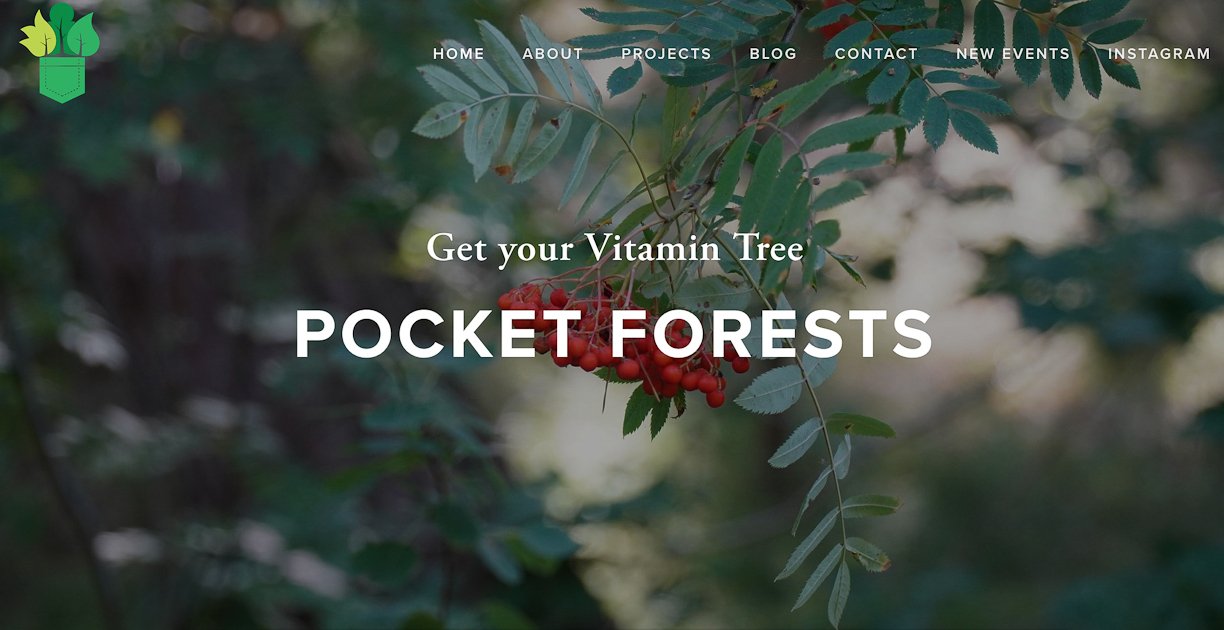
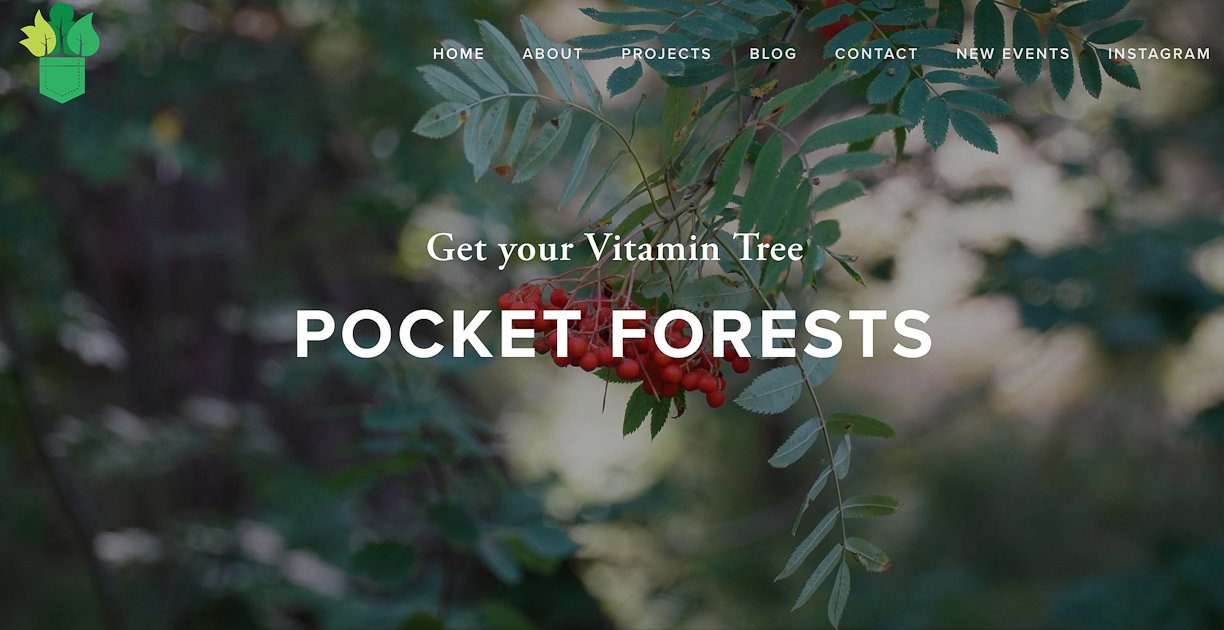
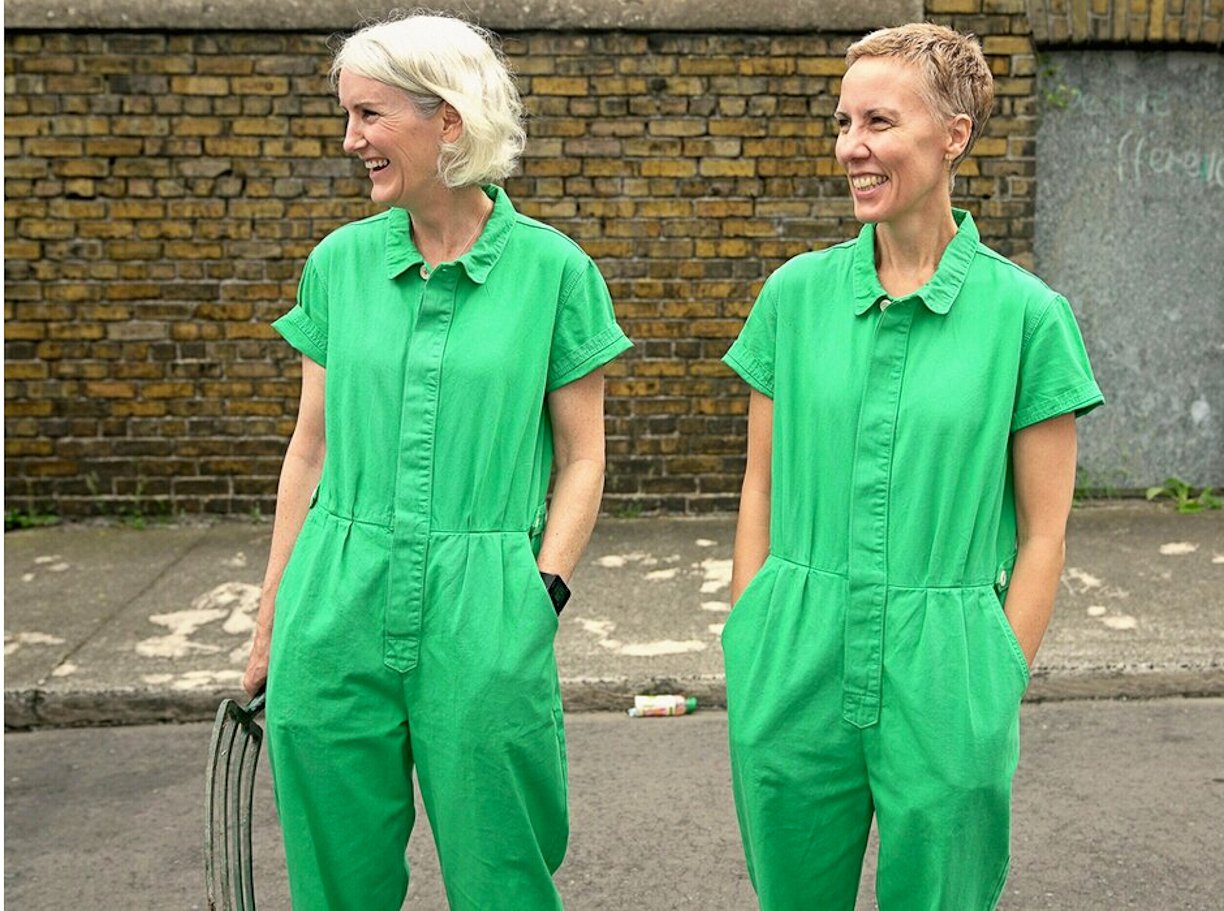




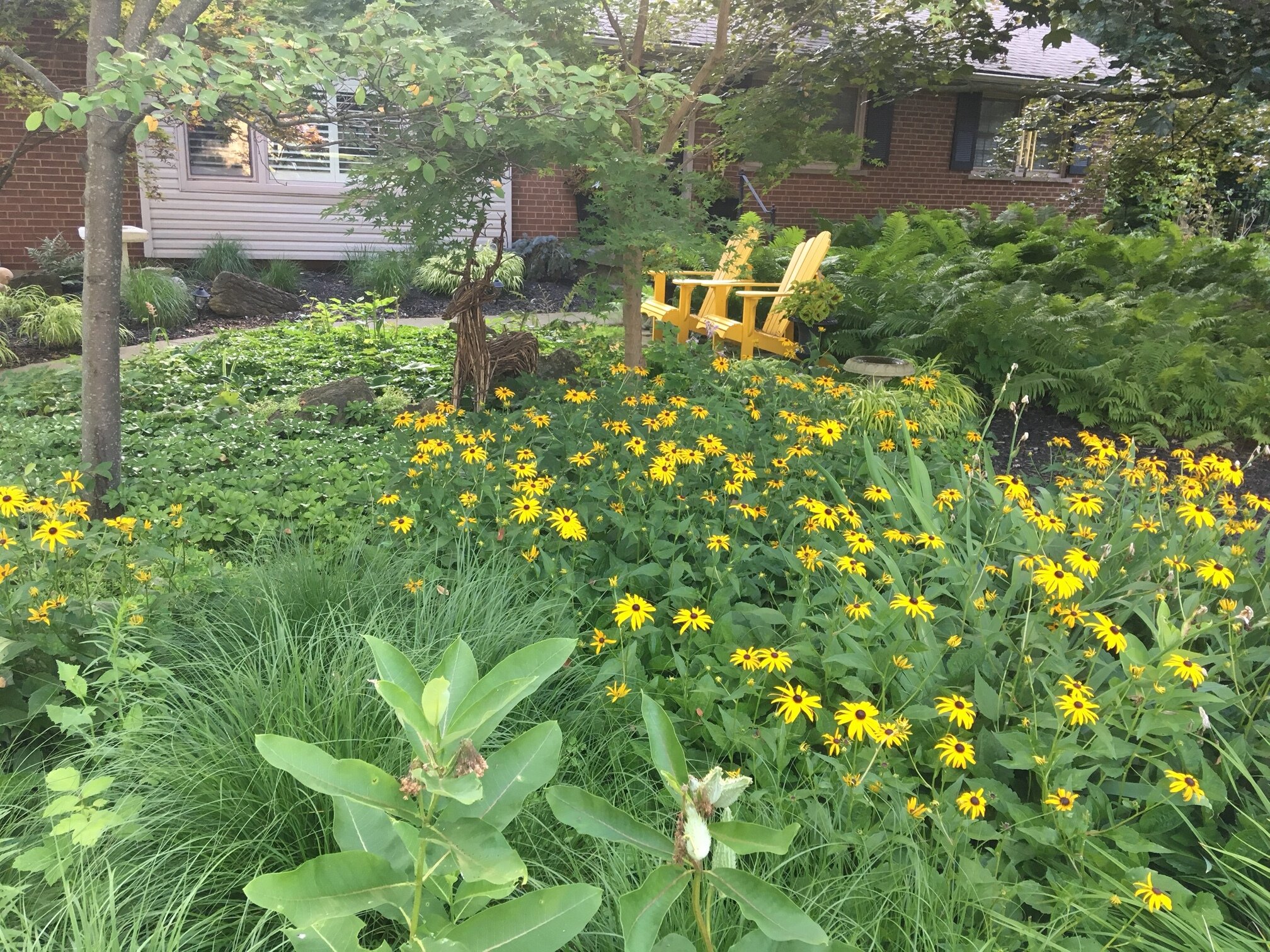

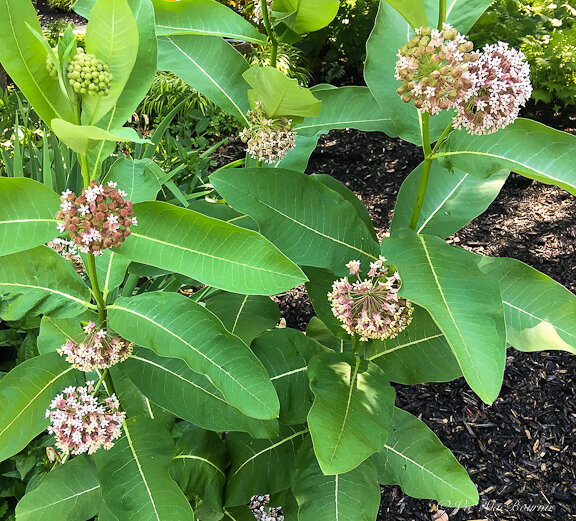
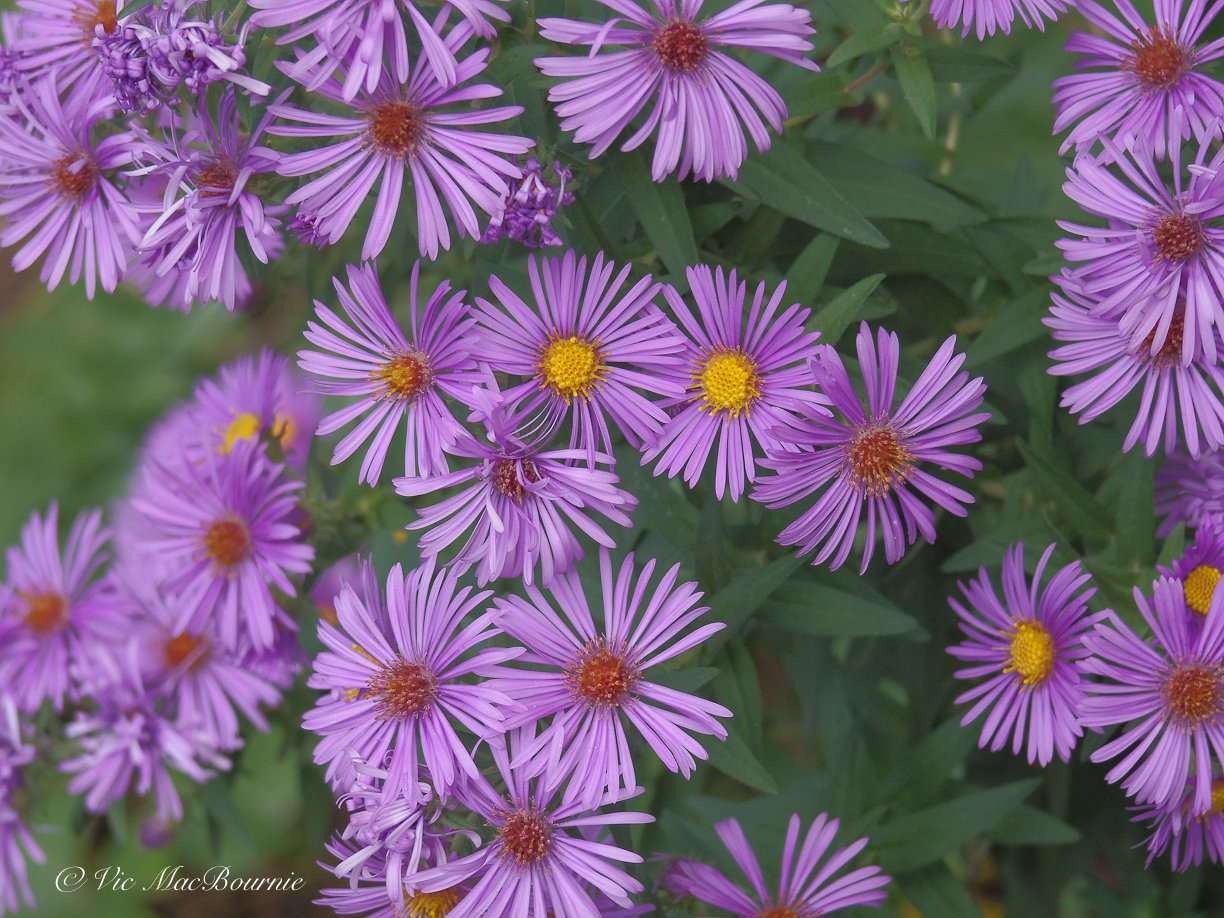
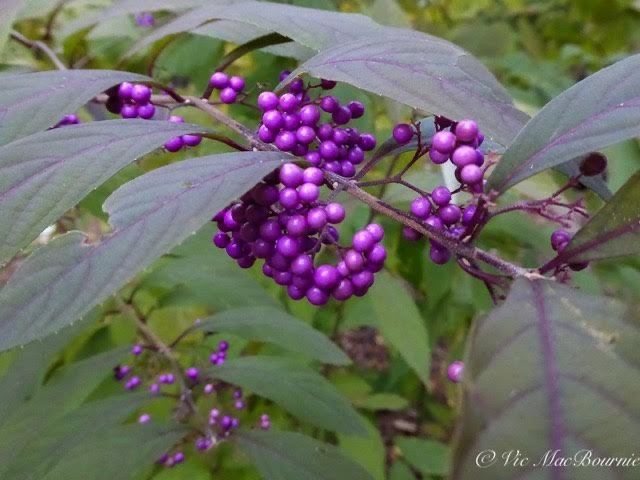





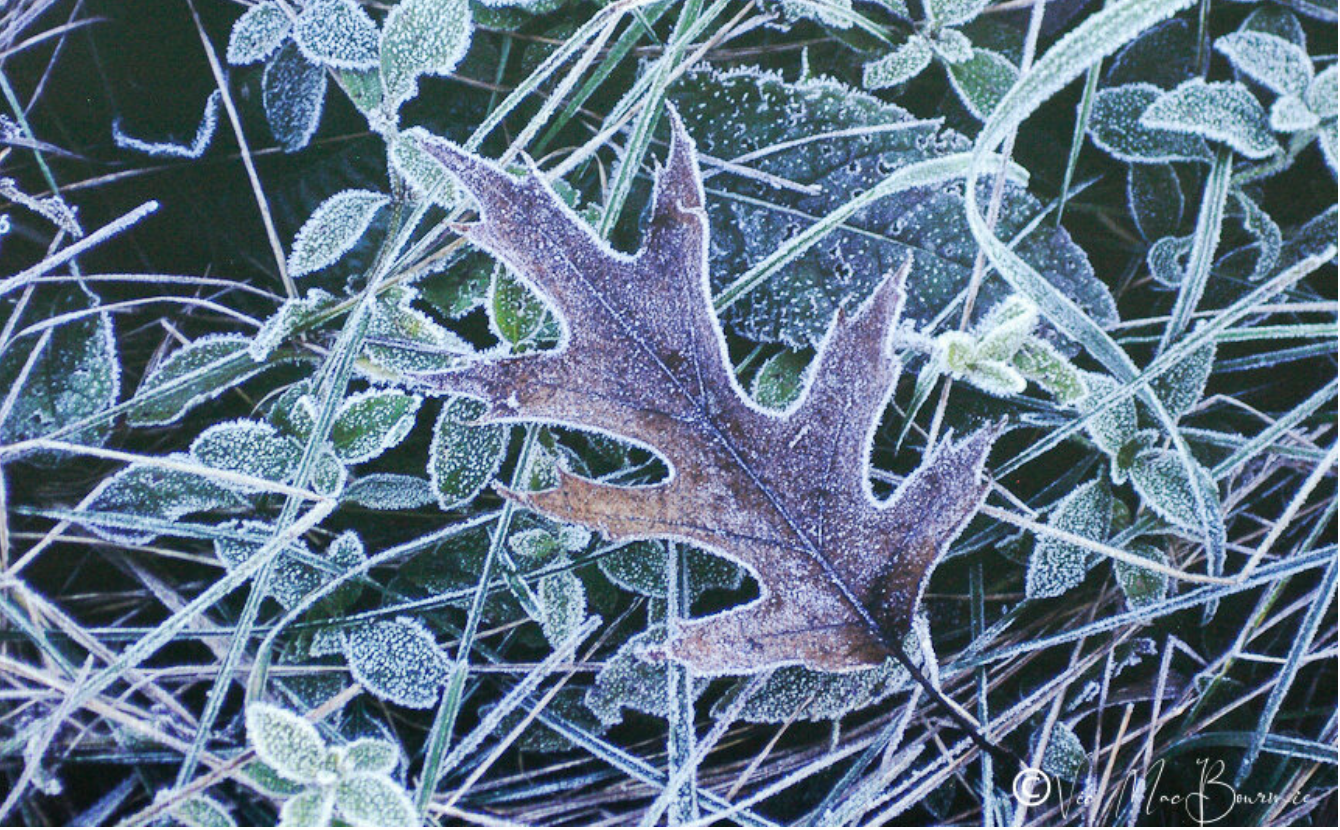
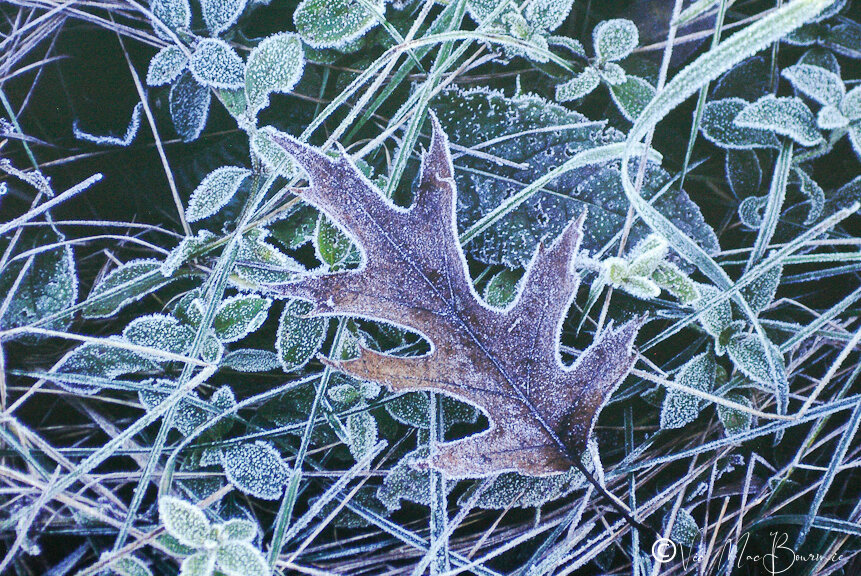
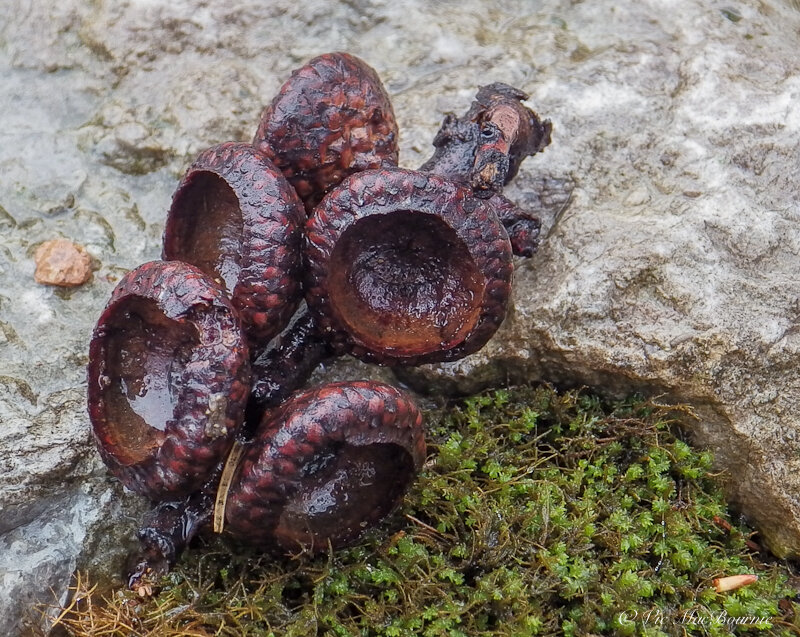
Staghorn Sumac is an excellent addition to the garden both to add architectural interest and provide a food source for birds and animals.